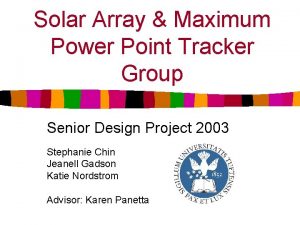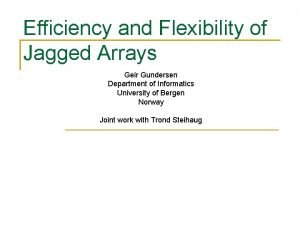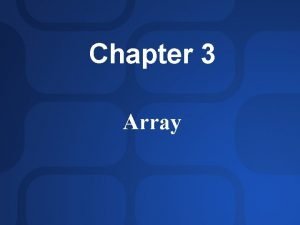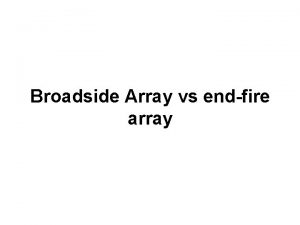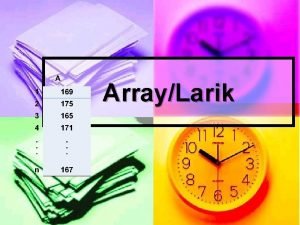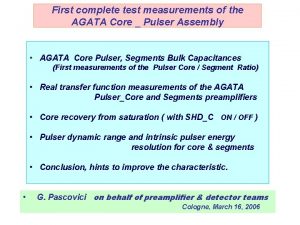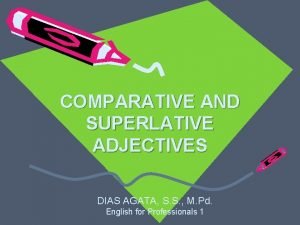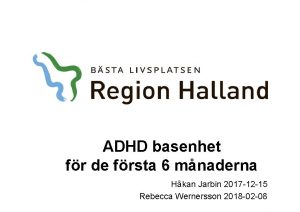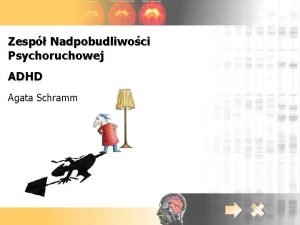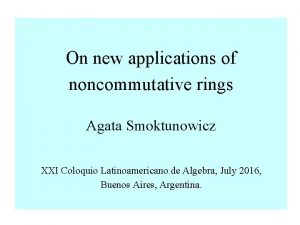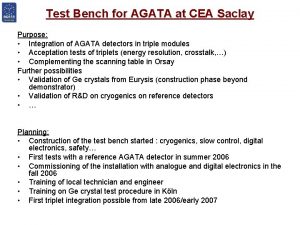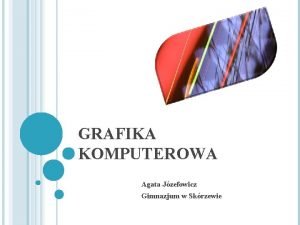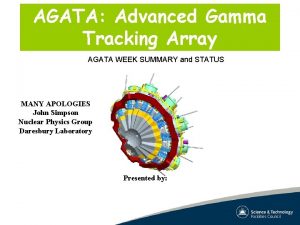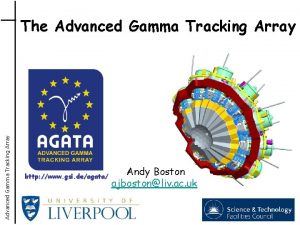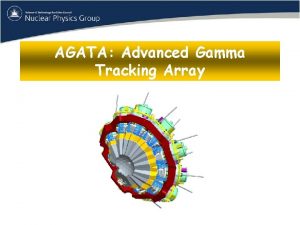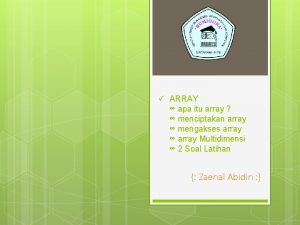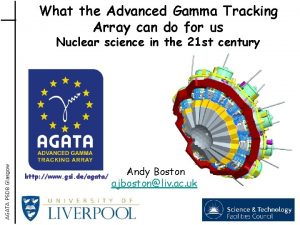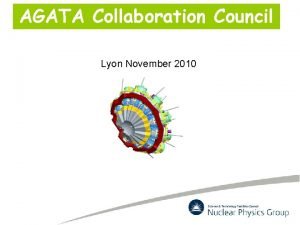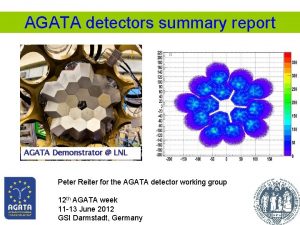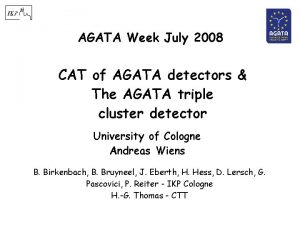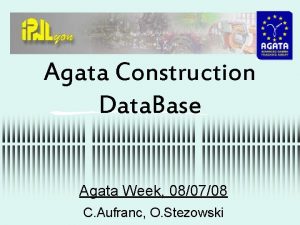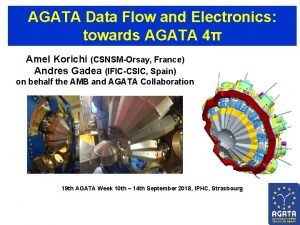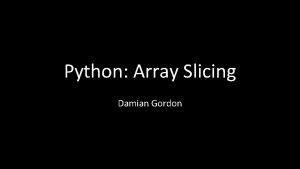Advanced GAmma Tracking Array Performance of an AGATA






















![q profile of experimental image Experiment peak FWHM [deg] q [deg] Comparison to MC q profile of experimental image Experiment peak FWHM [deg] q [deg] Comparison to MC](https://slidetodoc.com/presentation_image_h2/a693a1287518177b78054628c65ea2a3/image-23.jpg)






- Slides: 29

Advanced GAmma Tracking Array Performance of an AGATA prototype detector estimated by Compton-imaging techniques Francesco Recchia INFN - Legnaro on behalf of the AGATA collaboration

The g-ray spectrometer AGATA Rint = 23 cm 180 HPGe Design values: 5 mm of position resolution assumed Rext = 32 cm Efficiency: 43% (Mg=1) 28% (Mg=30) Peak/Total: 58% (Mg=1) 49% (Mg=30) today’s arrays ~10% today ~55% 5% 40% Angular Resolution: ~1º FWHM (1 Me. V, v/c=50%) ~ 6 ke. V today o o Triple cluster o ~40 ke. V 180 large volume 36 -fold segmented Ge crystals packed in 60 triple-clusters Digital electronics and sophisticated Pulse Shape Analysis algorithms Operation of Ge detectors in position sensitive mode for g-ray tracking

Ingredients of g-ray tracking Identified interaction points 1 Highly segmented HPGe detectors · · ·· g · · · (x, y, z, E)i Pulse Shape Analysis to decompose recorded waves 4 Reconstruction of scattering sequence from Compton vertices 3 2 Digital electronics to record and process segment signals Reconstructed gamma-rays

Pulse Shape Analysis concept A 3 A 4 A 5 (10, 46) B 3 C 3 B 4 C 4 B 5 C 5 (10, 30, 46) y CORE C 4 B 4 measured D 4 791 ke. V deposited in segment B 4 A 4 E 4 F 4 z = 46 mm x

Pulse Shape Analysis concept A 3 A 4 A 5 B 3 B 4 B 5 C 3 C 4 C 5 (10, 46) y CORE C 4 measured calculated 791 ke. V deposited in segment B 4 D 4 A 4 E 4 F 4 z = 46 mm x

Pulse Shape Analysis concept A 3 A 4 A 5 B 3 B 4 B 5 C 3 C 4 C 5 (10, 15, 46) y CORE C 4 measured calculated 791 ke. V deposited in segment B 4 D 4 A 4 E 4 F 4 z = 46 mm x

Pulse Shape Analysis concept A 3 A 4 A 5 B 3 B 4 B 5 C 3 C 4 C 5 (10, 20, 46) y CORE C 4 measured calculated 791 ke. V deposited in segment B 4 D 4 A 4 E 4 F 4 z = 46 mm x

Pulse Shape Analysis concept A 3 A 4 A 5 B 3 B 4 B 5 C 3 C 4 C 5 (10, 25, 46) y CORE C 4 measured calculated 791 ke. V deposited in segment B 4 D 4 A 4 E 4 F 4 z = 46 mm x

Pulse Shape Analysis concept A 3 A 4 A 5 B 3 B 4 B 5 C 3 C 4 C 5 (10, 30, 46) y CORE C 4 measured calculated 791 ke. V deposited in segment B 4 D 4 A 4 E 4 F 4 z = 46 mm x

Pulse Shape Analysis concept A 3 A 4 A 5 B 3 B 4 B 5 C 3 C 4 C 5 Result of Grid Search algorithm (10, 25, 46) y CORE C 4 measured calculated 791 ke. V deposited in segment B 4 D 4 A 4 E 4 F 4 z = 46 mm x

The position resolution required for the AGATA detectors Simulations suggest that the overall performance depends on the attainable position resolution A test-beam experiment has been performed to measure this parameter in realistic experimental conditions

Setup of the in-beam experiment Symmetric triple cluster d(48 Ti, 49 Ti)p BEAM 48 Ti TARGET 48 Ti 100 Me. V + 2 H 220 μg/cm 2 Thickness: 300 μm Si detector DSSSD 32 rings, 64 sectors AGATA symmetric triple-cluster experiment performed at IKP of Cologne Digitizers: 30 XIA DGF 4 c cards 40 MHz 14 bit Silicon detector

Doppler correction using PSA results 32 ke. V Full statistics used

Doppler correction using PSA results 11 ke. V 32 ke. V Full statistics used

Doppler correction using PSA results 4. 8 ke. V 11 ke. V 32 ke. V Full statistics used PSA algorithm: Grid Search

Simulation vs Experiment Recursive Subtraction Matrix Method Miniball Algorithm Grid Search Results obtained with different PSA algorithm

Why Compton imaging? o o o 15 days of beam-time to perform the test experiment 1 year of analysis PSA will be on-line Need for a simpler procedure Need an prompt feed-back from on-line analysis

Compton imaging o In-beam experiment: n o typical conditions of future use E 1 n inverse tracking E 2 target Compton imaging of a radioactive source q E 1 g-source q E 2

Error on Compton identification of source direction from: o Position resolution (axis) o Energy resolution (scattering angle) o Compton profile (scattering angle) angular error [deg] Compton imaging performance scattering angle [deg]

Imaging setup at LNL AGATA prototype detector TNT 2 Digitizers: 4 ch 14 bit 100 MHz 60 Co source

Outline of analysis/simulation DAQ MC Event selection PSA Smearing (position resolution) Image formation Position resolution

Comparison to simulation Simple back-projections MCE+ E res MC ≈ MC + E, p E res + pos res Exp ≈
![q profile of experimental image Experiment peak FWHM deg q deg Comparison to MC q profile of experimental image Experiment peak FWHM [deg] q [deg] Comparison to MC](https://slidetodoc.com/presentation_image_h2/a693a1287518177b78054628c65ea2a3/image-23.jpg)
q profile of experimental image Experiment peak FWHM [deg] q [deg] Comparison to MC simulation position resolution FWHM [mm] f profile of experimental image Monte Carlo + 5 mm position resolution peak FWHM [deg] q [deg] f [deg] 5. 2 4. 7 position resolution FWHM [mm]

CONCLUSIONS o o Position resolution extracted by in-beam experiment and Compton imaging is 5 mm FWHM. This value is in line with the design assumptions of the AGATA spectrometer, confirming the feasibility of g-ray tracking. AGATA will have a huge impact on nuclear structure studies (first phase of AGATA: LNL 2009…) Possible applications of g-ray tracking detectors to imaging.




Basic implementation of LMML 0 1 20 6

Compton imaging application
 Photovoltaic array maximum power point tracking array
Photovoltaic array maximum power point tracking array Advanced call tracking
Advanced call tracking Pin grid array and land grid array
Pin grid array and land grid array Array yang sangat banyak elemen nol-nya, dikenal sebagai
Array yang sangat banyak elemen nol-nya, dikenal sebagai Jagged array vs multidimensional array
Jagged array vs multidimensional array Associative array vs indexed array
Associative array vs indexed array Difference between broadside and endfire array
Difference between broadside and endfire array Apa itu larik
Apa itu larik Suatu array dikatakan lower triangular jika
Suatu array dikatakan lower triangular jika Contoh program array 1 dan 2 dimensi
Contoh program array 1 dan 2 dimensi Iptt
Iptt My florida market place
My florida market place Performance sports inc
Performance sports inc Agata kałużna mieszków
Agata kałużna mieszków Agata zielinski
Agata zielinski Agata miklis
Agata miklis Książka karolcia pdf
Książka karolcia pdf Agata core
Agata core Boring comparative
Boring comparative Snap iv svenska
Snap iv svenska Agata miklis
Agata miklis Agata miklis opole
Agata miklis opole Projekt agata
Projekt agata Agata smoktunowicz
Agata smoktunowicz Agata kocia
Agata kocia Agata miklis
Agata miklis Ks piotr bajor
Ks piotr bajor Agata thannhauser
Agata thannhauser Agata miklis
Agata miklis Dr agata jozefowicz
Dr agata jozefowicz
